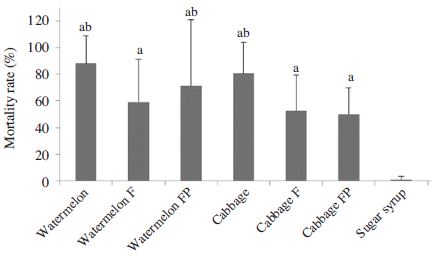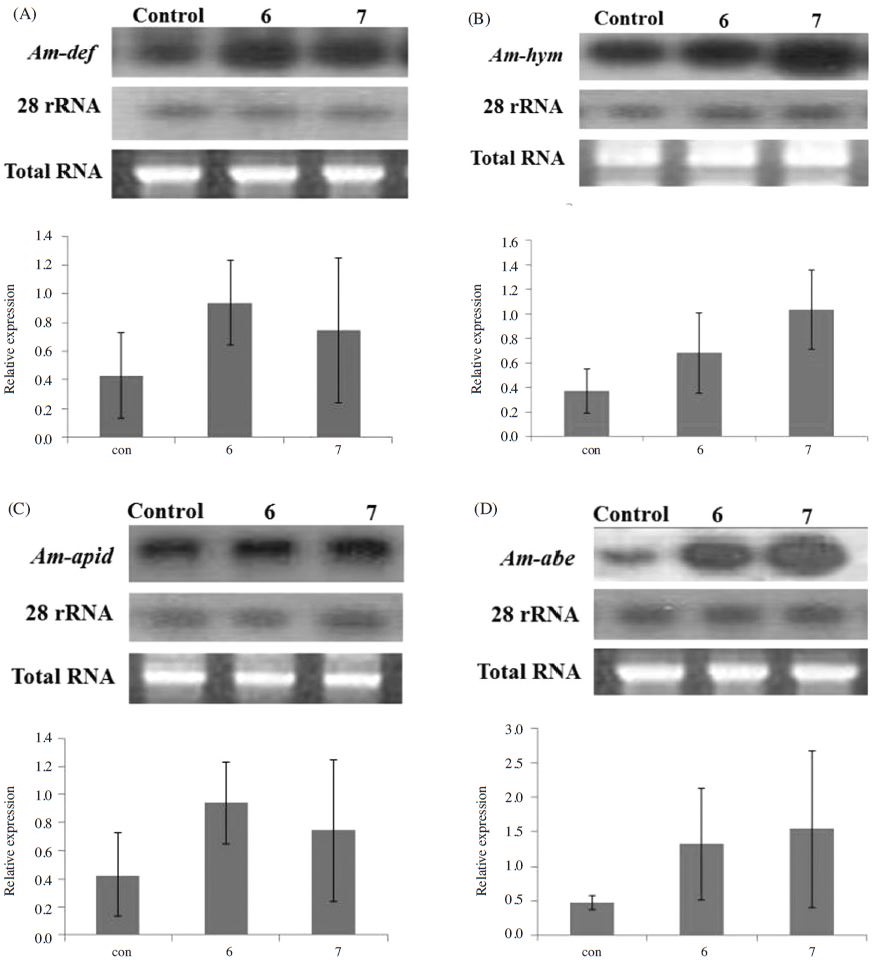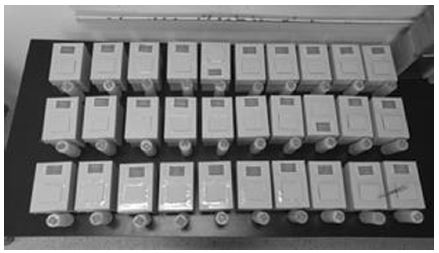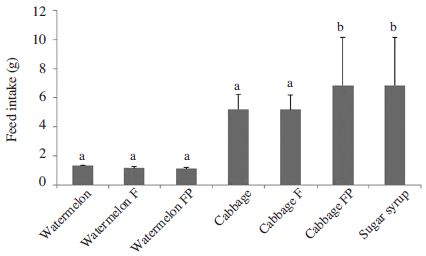
Research of Sugar from Vegetables to Supply Carbohydrate Sources to Honeybee, Apis mellifera
Abstract
Honeybees (Apis mellifera) are well-known for their elaborated division of worker with each bee performing a series of social mission. Colony organization is based on age-dependent division of worker. Honeybees performed several mission: nursing, cleaning or sealing brood cells, producing honey, collect pollen and nectar. The nectar is carbohydrate source for making energy. Korea has a very short blooming season for producing honey due to climate condition. So, almost Korean beekeepers have been supplied sugar syrup to honey bee for their carbonate source. Unfortunately, recently, the price of sugar has risen so much that the production cost of beekeeper has risen. We are extracted several sugars from plants for using carbohydrate source to bee. 3 sugar sources were extracted from plants (watermelon, cabbage, and mandarin). Almost sample showed high level of insecticidal rate and low level feed intake rate. We were selected 2 type of cabbage sugar syrup that low level insecticidal rate and high level feed intake rate (No. 6 cabbage (+fructose) was mixed with 10% fructose and No. 7 cabbage (+pollen) was made with 10% pollen). Cabbage sugar solution has much more impurities than purified sugar. So, No. 6 and No. 7 sample can do up-regulation of antimicrobial genes (apideacin, defencin, abacin, and hymenopteacin). Cabbage sugar solution has much more impurities than purified sugar. Our results suggest that up-regulation of antimicrobial genes might be involved in worker through carbohydrate impurities related immune pathways.
Keywords:
Honeybee, Apis mellifera, Apideacin, Defencin, Abacin, Hymenopteacin, Cabbage sugar, CarbohydrateINTRODUCTION
Sugar is the most important source of energy for honeybees, they collect and use nectar from flowers. In general, total sugar content of nectars range from a minimum of 5% to maximum of 80% (Graham, 1992). However, some of the nectar sources are made of much fructose and glucose except for a small amount of sucrose (Chalcoff et al., 2006; Ball, 2007; Stanley et al., 2013; Bertazzini and Forlani, 2016). Climate conditions are the most important to raise honeybees. If various nectar sources are to be supplied enough as a feed to honeybees throughout the year, it becomes very easy to manage honeybees with less cost. However, there are four seasons in Korea, and bees need to pass the winter and have honey flow period for about two months as a part of disadvantageous conditions for managing honeybees in Korea. Especially, if not supplying honeybees with feed made of sugar syrup from early spring to late summer when nectar sources are not available, it is impossible to manage honeybees. Under these circumstances, Korea completely relies on importation of sugar. Due to a continuous increase in the price of sugar, there has been an increasing burden on production costs in bee farms. Therefore, it is urgent to advance research for the development of sugar in a form that does not cause problem in production of honeybees and also is cheaper than sugar.
However, as a feed to be accumulated, it can be used for long distance flying or external activities as it is accumulated in the form of glucose in the body of honeybees in the similar form of other insects (Beutler, 1950; von Frisch, 1967; Beenakkers et al., 1984; PanZenbock and Crailsheim, 1997). Therefore, research has been performed using the most fundamental source of energy, sugar, for honeybees as an agricultural byproduct, sugar is extracted while selecting sugar extract to be applied on honeybees in this study.
MATERIALS AND METHODS
Samples
Sugar samples extracted from agricultural by-products such as watermelon, and cabbage were the ones extracted, refined, and manufactured from the research team from Chonnam National University (Table 1). Watermelon extract, watermelon extract + fructose (10%), watermelon extract + fructose (5%) + pollen (5%), cabbage extract, cabbage extract + fructose (10%), cabbage extract + fructose (5%) + pollen (5%) were used (Fig. 1). In order to apply the honeybees in such samples, brix was corrected to 50 consistently, and fifty young worker bees were kept into the paper cage to supply water and feed, respectively (Fig. 1).
Northern blotting
Northern blotting was separated with total RNA by using Trizol proceeding electrophoresis with formamid gel, transferring them to nitrocellulose membrane for 18 hours, and cross-linked with UV. Membrane was proceeded with pre-hybridization with hybridization solution and hybridized for 18 hours afterwards. Probe was exposed to X-ray film for 24 hours by labeling the radiation isotope p32 on PCR outcome of immue-related genes (abaecin, dafencin, apidaecin, hymanopteacin) and printed by using development solution and fixer.
cDNA synthesis and Quantitative PCR (qPCR)
In order to confirm the gene expression related to immune of honeybees samples supplied with cabbage extracts, honeybee samples were separated with total RNA by using Trizol. After freezing and pulverizing the samples with liquid nitrogen, 200μl chloroform and Trizol 1ml were mixed with 100mg sample and vortexed for fifteen seconds and reacted in the room temperature for two to three minutes. After the reaction, sample was centrifuged in conditions of 12,000xg and in 4°C for fifteen minutes separating the supernatant and mixing it with 500μl isopropanol to react in the room temperature for ten minutes. Then, they were centrifuged in conditions of 12,000xg and in 4°C for fifteen minutes, and pellet was cleaned with 80% EtOH. Final pellet was used for cDNA synthesis by melting it in the DEPC water. cDNA synthesis was reacted in 65°C for five minutes with PrimeScript II 1st strand cDNA Synthesis kit by using oligo dT primer with extracted total RNA as a mold. Then, they were cooled down in ice, and cDNA was synthesized in 42°C for sixty minutes.
Synthesized cDNA was used as a mold to amplify four types of honeybee immune-related genes, defencin, hymenopteacin, apidaecin, and abaecin. As for abeacin cene, the forward primer, 5’-CGCACTACTCGCCATGCGCAGC-3’, Reverse primer 5’-GGACGATTAATAGCCTTGAGGCC-3’, was used. As for hymenoptaecin gene, forward primer, 5’-GTGCCGTTGC ATACGTTTCTGCTC-3’, and the reverse primer, 5’-GTCCACCATAGGCGTCTCCTGTC-3’, were used. As for apidaecin gene, forward primer, 5’-GAACCGCTGCTACCACTACG-3’, and reverse primer, 5’-GTCGAGTAGGCGGATCTAG-3’ were used. As for defencin gene, forward primer, 5’-GAACCGCTGCTACCACTACG-3’, and reverse primer, 5’-CCATTTCTGCAACTACCGC-3’, were used. As for control gene, β-actin gene was used. qPCR was set to have the final volume as 25μl that 10 pmol primer, 1×SYBR Green (Applied Biosystems), and 1st strand cDNA 1μl were mixed to react. With analysis of Ct value of final result of reaction, the amount of expressed gene was compared (Applied Biosystems, user bulletin #2).

Impact of honey bee on agricultural byproducts. lane 1: watermelon, lane 2: watermelon + fructose (10%), lane 3: watermelon + fructose (5%) + pollen (5%), lane 4: cabbage, lane 5: cabbage + fructose (10%), lane 6: cabbage + fructose (5%) + pollen (5%), lane 7: sugar syrup.
RESULTS AND DISCUSSION
Preference of honeybees and death rate of sugar extracted from agricultural byproducts
In order to analyze influence of dietary treatments on the honeybees, we recorded the mortality (number of dead bees) and preference (feed consumption rate) of honeybees samples. According to the result of supplying samples to the honeybees for three days, the death rate of bees was 88% for watermelon extract, 59.3% for watermelon extract + fructose, 71.3% for watermelon extract + fructose (5%) + pollen (5%), 80.7% for cabbage extract, 52.7% for cabbage extract + fructose (10%), 50.0% for cabbage extract + fructose (5%) + pollen (5%), and 1.3% for sugar liquid as a control solution.
In addition, according to the result of feed preference, the amount of food ingested by honeybees was 1.3g for watermelon extract, 1.2g for watermelon extract + fructose (105), 1.1g for watermelon extract + fructose (5%) + pollen (5%), 5.2g for cabbage extract, 5.2g for cabbage extract + fructose (10%), 6.9g for cabbage extract + fructose (5%) + pollen(5%), and 2.2g for sugar liquid as a control solution. Therefore, cabbage extract has lower death rate than watermelon but with higher feed preference. Especially, cabbage extract turned out to have higher feed preference than the sugar liquid, the control solution, which could be chosen as the alternative feed.
As watermelon and cabbage extracts have the black color, it seems that their samples contain various foreign substances. It also seems that there are cases where such foreign substances lower the preference in honeybees and serve as toxicity. Therefore, it is important to refine toxic substances on honeybees through many refining procedures and improving preference. At the same time, it seems to be inevitable to develop the process in consideration of economic feasibility to guarantee the possibility of it as an alternative of sugar. In recent years, with the steady rise in sugar prices in Korea, it is very necessary to develop honeybee feed that can substitute sugar. However, until now, it is very difficult to develop a sugar of cheaper price than the sugar price. However, if we can produce substitution sugar using agricultural byproducts, we think that it will be able to have price competitiveness. If we simplify the production process and reduce the cost in glycation process, it will be competitive with sugar. I Korea, sugar is not registered as a feed for bees. Because sugar bees are registered as feed for bees, some beekeepers may produce sugar honey. So, expensive sugar is used as feed for bees. Therefore, the use of alternative sugar as a bee feed is expected to reduce the administrative costs of beekeepers because the government subsidizes the cost of the feed. So, even if the substitute feed is higher than the sugar price, beekeepers will be able to feed the feed at a cheaper price than sugar.
Since the mixture of cabbage extract and fructose and also the one of fructose and pollen among cabbage extracted tested in this study turned out to provide the best result, gene expression test has been conducted on immunization of honeybees by collecting honeybees supplied with their samples. As a result, expression of four types of antibacterial proteins in regard of immunization (Apidaecin, Defencin, Hymenopteacin, Abaecin) turned out to all increase (Fig. 4). Apidaecin, Defencin, Hymenopteacin, and Abaecin are major antibacterial protein in honeybee. As for causes of an increase of expressed anti-bacterial protein, if samples being taken serve as a toxicity on honeybees causing the stress on honeybees, the amount of expression increases. Therefore, if deriving the expression of immune proteins without causing toxicity in honeybees, it seems that they will have the value as a functional feed.

Transcriptional expression of the antibacterial genes in cabbage sugar treated colony (upper). Northern blot analysis of the defencin (A), Hymenopteacin (B), Apideacin (C), Abaecin (D) in A. mellifera. Total RNAs were isolated from the worker (lane 1), cabbage sugar eat worker (lane 2), cabbage sugar and fructose eat worker (lane 3). The RNAs were separated by 1.0% formaldehyde agarose gel electrophoresis, transferred onto a nylon membrane and hybridized with radiolabled 1,695-bp Juvenile Hormone Esterase like (Acjhelike) gene. (Lower) Transcript levels of antimicrobial genes in different treats by qPCR (t-test, P<0.001).
When extracting sugar from agricultural byproducts, the extracted sugar is rich in color when it does not go through many processes. It is presumed that the cause is due to a lot of impurities such as various minerals in the plant. These impurities may be toxic to bees in some cases, but may also act as functional substances with an effect of improving the physiology of bees. Therefore, as the result of this study, it has been confirmed that the expression of immune-related substances of bees is increased, and thus it is expected to act as a material having a specific function to bees. However, it is a problem that food preference is very low due to unique flavor and taste. So, if bee prey preference for alternative feeds improves, it will be available in apiaries.
Acknowledgments
This study is a result researched with resource from PJ012441012017 of national joint research business in National Institute of Agricultural Sciences in Rural Development Administration.
LITERATURE CITED
-
Ball, D.W., (2007), The chemical composition of honey, J. Chem. Educ, 84, p1643.
[https://doi.org/10.1021/ed084p1643]

-
Beenakkers, A.T., Van der Horst, D., Van Marrewijk, W., (1984), Insect flight muscle metabolism, Insect Biochem, 14, p243-260.
[https://doi.org/10.1016/0020-1790(84)90057-x]

- Bertazzini, M., Forlani, G., (2016), Intraspecific variability of floral nectar volume composition in rapeseed (Brassica napus l. var. oleifera), Front. Plant Sci, 7.
-
Beutler, R., (1950), Zeit und Raum im Leben der Sammelbiene, Naturwissenschaften, 37, p102-105.
[https://doi.org/10.1007/bf00623715]

- Chalcoff, V.R., Aizen, M.A., Galetto, L., (2006), Nectar concentration composition of 26 species from the temperate forest of South America, Ann. Bot, 97, p413-421.
- Graham, J.M., (1992), The Hive the Honey Bee, Dadant Sons, Hamilton.
- Panzenböck, U., Crailsheim, K., (1997), Glycogen in honeybee queens, workers and drones (Apis mellifera carnica Pollm.), J. Insect Physiol, 43, p155-165.
- Stanley, D.A., Gunning, D., Stout, J.C., (2013), Pollinators and pollination of oilseed rape crops (Brassica napus L.) in Ireland: ecological economic incentives for pollinator conservation, J. Insect Conserv, 17, p1181-1189.
- von Frisch, K., (1967), The Dance Language and Orientation of Bees, Harvard University Press, Cambridge, Mass.

